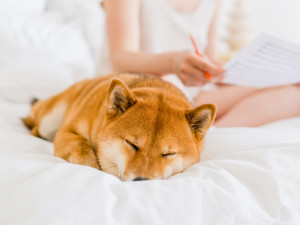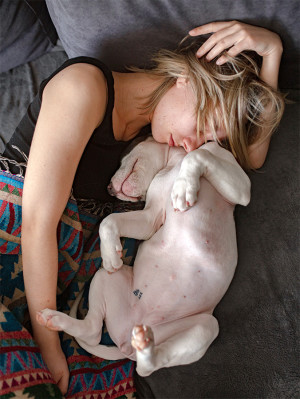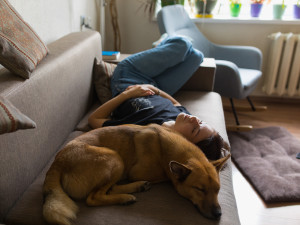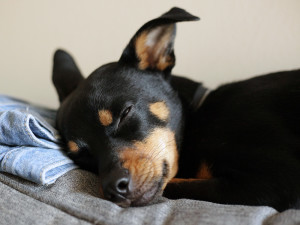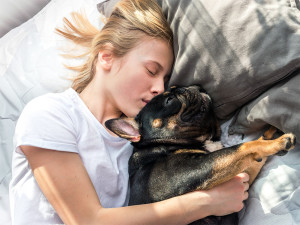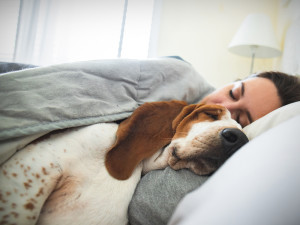The Adorable Reason Your Dog Likes To Sleep On Their Back
Four legs up to the ceiling might not seem like a comfy napping position to us but pups seem to love it. How come?

Share Article
Have you ever caught your dog sprawled out on their back, legs in the air, looking completely at peace? This sleeping position might seem odd to us humans, but for dogs, it’s perfectly natural.
In fact, how your dog sleeps can tell you a lot about their health, comfort level, and even their personality.
To understand why they sleep in unique ways, we asked Dr Kate McCrossan, a veterinary surgeon practising in Northern Ireland, why dogs sometimes sleep on their back.
The ‘normal’ sleeping positions for dogs
Before we explore the belly-up position, let’s take a look at some of the more common sleeping positions for dogs and what they reveal about your furry friend.
The side sleeper
One of the most common sleeping positions for dogs is lying on their side with their legs extended.
“This position is especially common in puppies or older dogs who may have stiff joints,” says Dr Kate. “However, all dogs who are safe and comfortable in their environment tend to sleep this way. Weather can also play a role; on a hot day, your dog might lie on their side on a cool surface to help regulate their body temperature.”
The lion pose
Also known as the sphinx pose, this position involves your dog lying on their belly with their head resting on their front paws. Dogs who sleep like this are usually in a light sleep and ready to jump up and play at a moment’s notice.
“It’s a common pose for dogs who are naturally alert and protective, often seen in dogs who like to keep an eye on their surroundings,” says Dr Kate.
The Superman pose
Some dogs, particularly breeds like French Bulldogs and Pugs, love to stretch out on their stomachs with their back legs extended straight behind them and their front legs outstretched. This ‘Superman’ pose is as playful as it looks. Dogs who sleep like this are often full of energy and ready for action at any time.
The doughnut
In the doughnut pose, dogs curl up into a tight ball with their limbs tucked close to their bodies and their nose near their tail. “This position is common among dogs who are either trying to conserve warmth or who feel the need to protect themselves in some way,” says Dr Kate.
It’s a cosy, protective position often seen in dogs who are a bit reserved or are adjusting to a new environment. It’s also adorable!
The cuddler
If you have a cuddler, lucky you – dogs who love to cuddle during sleep are showing signs of affection and seeking comfort. This behaviour often stems from their days as puppies, when they would snuggle up with their littermates for warmth and security. As they grow older, this habit continues, turning into a comforting ritual that strengthens their bond with you.
The belly-up position: why do dogs sleep on their backs?
Now that we’ve covered the more common positions, let’s get to the heart of the matter: why does your dog sleep on their back with their legs in the air? This adorable and often funny position can tell you a lot about your dog’s comfort level, health, and even emotional state.
Here are a few reasons why your dog enjoys lying on their back:
They’re cooling off
One of the primary reasons dogs sleep on their backs is to cool down. “Dogs have fewer sweat glands than humans, and the majority of these glands are located in their paws,” says Dr Kate. “When a dog sleeps on their back with their paws in the air, they are allowing heat to escape more easily, helping them to cool off. The belly area has less fur than other parts of the body, making it easier for your dog to catch a breeze and lower their body temperature.”
During hot weather, you might notice your dog adopting this position more frequently, especially if they’ve been active or if the house is warm. If your dog is also panting with their tongue out while in this position, it’s a sign that they are trying to cool down, as panting is another way dogs regulate their body temperature.
They feel safe and secure
Sleeping on their back is one of the most vulnerable positions a dog can adopt, as it exposes their vital organs. If your dog chooses to sleep like this, especially when lying next to you or in a busy area of the house, it’s a strong sign that they feel safe and secure. Your dog trusts you and their environment enough to let their guard down completely.
“This position can also be a communication signal to other dogs or animals, indicating that they are not a threat and are completely relaxed. It’s important to note that just because your dog is showing their belly, it doesn’t necessarily mean they want belly rubs. Always observe your dog’s body language and respect their comfort level,” adds Dr Kate.
It’s simply comfortable
Sometimes, the reason is as simple as comfort. When dogs sleep as much as they do – adult dogs usually clock in around 11 hours of sleep a day, while puppies can sleep up to 18 hours – they need to find positions that are cosy and relaxing. Lying on their back can relieve pressure on their joints and muscles, making it an ideal position for dogs who need to stretch out after a long day of play.
“If your dog doesn’t sleep on their back, don’t worry. Some dogs, especially older ones or those with joint issues, may find this position uncomfortable. Instead, they might prefer sleeping on their side or in the doughnut position. Always consult your vet if you notice significant changes in your dog’s sleeping habits, as this could be a sign of underlying health issues,” says Dr Kate.
They’re showing submissive behaviour
In the dog world, rolling onto the back is a sign of submission. If your dog adopts this position when approached by another dog, they are likely signalling that they are not a threat and prefer to avoid confrontation. This submissive posture can also occur during playtime with humans or other dogs, indicating that your dog is in a relaxed, non-aggressive state.
It might help them breathe easier
Breeds with brachycephalic (short-nosed) features, such as Pugs, Boston Terriers, French Bulldogs and Boxers, might sleep on their backs to help alleviate breathing issues caused by their skull shape, say Dr Kate. “If your dog belongs to one of these breeds and frequently sleeps on their back, it could be their way of finding a position that allows them to breathe more easily.”
Is it healthy for dogs to sleep on their backs?
“For most dogs, sleeping on their back is perfectly normal and healthy,” says Dr Kate. “However, it’s always good to be aware of any potential health implications.“
Studies have shown that brachycephalic dogs routinely get worse sleep than their longer-nosed peers, amongst a whole host of other health problems. Dr Jamie Freyer, a veterinarian and manager of data and veterinary genetics at Wisdom, told Kinshipopens in new tab. “They are breathing in air through a small opening, and then when the breath gets to the back of their throat, it reaches another obstacle, which makes breathing in general hard. And that difficulty breathing can, in part, lead to concerns around heat stroke, heart problems and other issues.”
Senior dogs or those recovering from surgery might also prefer sleeping on their back, as it reduces pressure on sore joints and muscles. If your dog is older or has been diagnosed with arthritis, consider providing them with an orthopaedic dog bed to offer extra support and comfort.
Dogs have many unique sleeping positions, each with its own meaning. Sleeping on their back is one of the most unusual positions, often indicating that your dog is cool, comfortable, and confident in their surroundings. While it might look amusing, this position is a natural way for your dog to relax and enjoy a good nap.
If you notice your dog adopting this position more frequently, it’s generally a good sign that they feel safe and secure in their home. And remember, whether your dog is a side sleeper, a cuddler, or a belly-up napper, what matters most is that they’re happy, healthy, and comfortable.
Resources
6 Dog Sleeping Positions and What They Meanopens in new tab
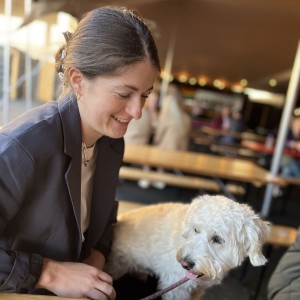
Nuala McHugh
Nuala is a writeropens in new tab with a background in PR. She has worked with brands including Jollyes, Universal Studios, and Amazon. Based in Northern Ireland, she is now doing what she loves most: writing with her clingy cockapoo Bobby by her side.
Related articles
![a puppy sleeping with their eyes open]()
Can Dogs Sleep With Their Eyes Open?
Dogs: they’re not just like us
![Girl sleeping with her French Bulldog dog in bed.]()
A New Study Finds Flat-Faced Dogs Get Pretty Crappy Sleep
It’s one of several health problems facing brachycephalic breeds
![woman with black curly hair sleeping in bed with her long hair daschund]()
Safe Sleep With Your Small Dog
Is there anything better than snuggling up to your pup all night? Here’s how to do it safely
![Woman and dog sleeping together in bed]()
Where Should Your Dog Sleep At Night-Time?
It’s a personal preference, but here are the pros and cons

